Hà Nội day one: the Old Quarter & the Temple of Literature
The Old Quarter, The Note Coffee Shop, Hoàn Kiếm Lake, and Văn Miếu, the Temple of Literature
Thanks for visiting Narrative Nation!
I’ve returned to Vietnam for a solo adventure after walking the streets in my mind many times since visiting with family in 2019. This trip includes the capital city Hà Nội; a homestay by Sông Lô (the Lo River) in Hà Giang, the country’s northernmost province bordering China; and a two-day motorbike ride on the famous Hà Giang loop. This is such a fascinating place. Beyond the stunning landscapes and the exciting pace of the city, there is so much interesting patriotic and nationalist art and public history to consider. I’m likely to add more information to some of these posts over time.
Enjoy!
For my first day, I started with a place I wanted to revisit from our earlier trip before heading to two places we missed during our short time in Hà Nội. Here are some images from my walk through the Old Quarter on the way to the famous Hoàn Kiếm Lake.



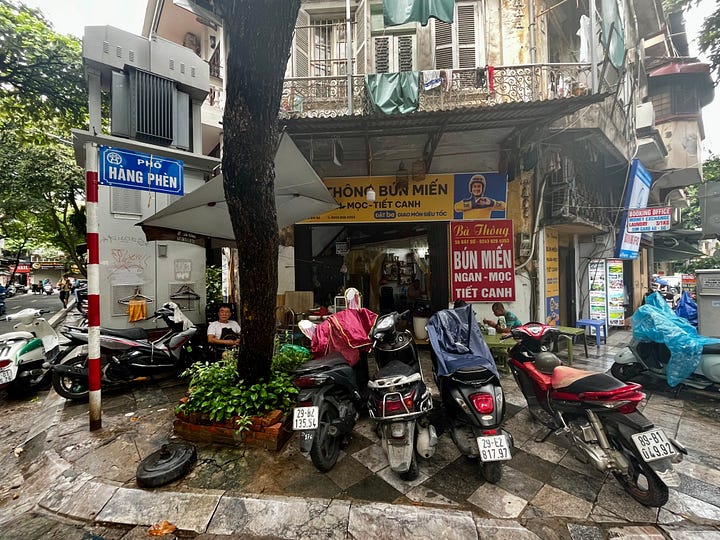
Thirty-Six Streets
For tourists and also for the Vietnamese, the Old Quarter is known for its exciting narrow streets where vehicles and pedestrians weave, surge, and gently beep in a constant peaceful progress past its many boutique hotels, spas, gift shops, and countless places to get a Bia Hà Nội, a fresh watermelon juice, a coffee, or the ubiquitous bahn mì and phở.
The Quarter is not only for entertainment and hospitality; there are also hundreds of utilitarian shops, and the area’s organization is easy to discern in spite of the initial sense of overwhelm that may have you feeling every single block offers every single thing. Not at all. Part of one block has 10 or more very small shops selling only cabinet and drawer handles and knobs. Another series of narrow shops sells padlocks, chains, fencing, and things in that category. One section has aluminum parts and accessories for all types of food carts and restaurant equipment: trays, deep fryer dippers, boiler pots, tongs. A few shops bunched together repair and resell luggage, motorcycle seats, and office chairs.

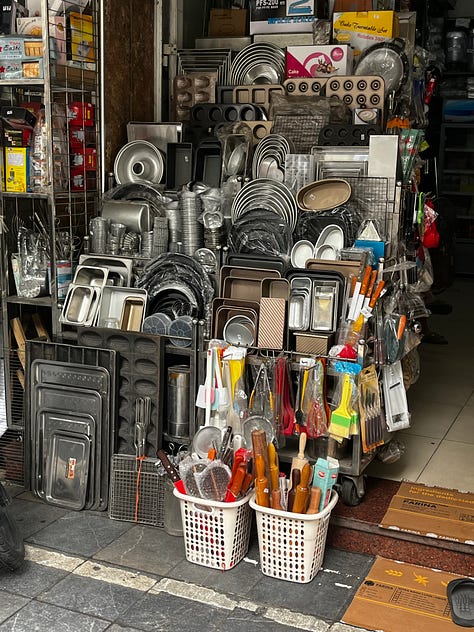


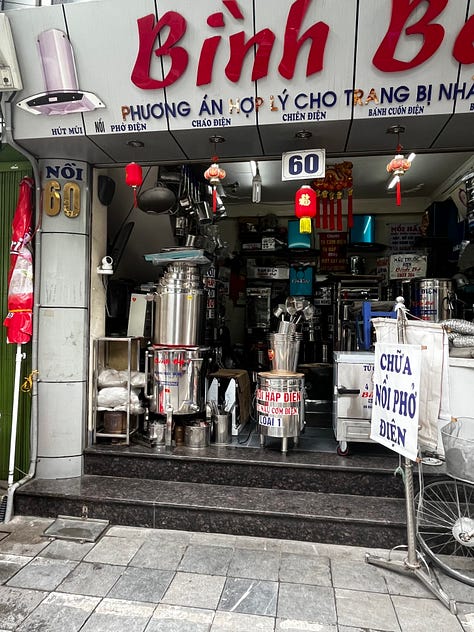

These historic streets are featured in a book I recently read, a multi-generational family story by Nguyên Phan Quê Mai, The Mountains Sing (2020). The primary narrator’s grandmother is a small landowner who narrowly escapes her village during the short but violent period of land reforms in the 1950s. After sacrificing or trading everything she has, and completing the long walk north to Hà Nội, she is guided to Silver Street where she restarts her life as a laborer before eventually becoming an undercover goods trader in the city’s black market.
The grandmother’s first impression in the mid-1950s is not a bad fit for today.
It was dark when we got to the Old Quarter, a maze of lanes woven along old, slanting houses. I gazed up at the bright streetlights atop metal poles. It was much busier here. Life spilled onto the pavement. People were cooking, washing, and drinking tea outside their homes, their voices soft whispers against the wind.
“Here you are. Silver Street. Good luck.” (241-2).
At this link, the author reads from this wonderful debut novel, describing a home on Silk Street.
For me, reading a good novel is like walking alone through the streets of a city. Both are life-affirming, expansive experiences with the potential for numerous return trips to the rabbit hole. On a richly stocked website called Saigoneer, I found these Old Quarter photos from the same era described in that part of the novel.



Silver Street is often described as the oldest street in Vietnam, dating to the 13th century. You can read a little more on the history of the “36 streets” (really there are more than 70 in the Old Quarter) in this short but solid article from Hanoi Little Ambassadors. The number 36 may be associated with the number of trade guilds that initially established workshops there before the specialized market streets developed, or it may be more like a metaphor multiplying the number nine, which generally represents numerousness, by the four cardinal directions.
On to The Note
Before I could lounge at The Note with my much-awaited cà phê trứng (egg coffee, a Hà Nội specialty), I needed to find a different charger for the Mac laptop I lugged across the planet so I could teach my online literature class. The guy at the tiny corner shop pictured below considered my situation, pulled out a few options to discuss with another customer who walked up, and sold me the perfect adapter for 1,000,000 VND ($41 USD). He put a small sticker inside the box in case I had trouble so he would know it came from him. I had been confidently sent to him by someone in the larger store I entered first.
As I noticed last time I visited Vietnam, interactions here are detailed and thoughtful. Trusting people across a significant language barrier is my happy role in this, after which I’m content to enjoy myself walking around until I eventually find what I’ve been directed to in this forgiving web of streets. When I notice sometimes that I’m walking down the same block twice, then surely there is more to see on a second pass.



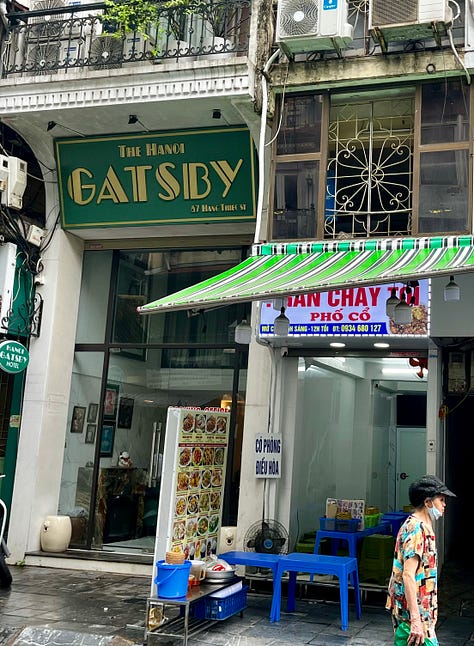


I arrived at The Note and ordered a cà phê trứng and a slice of soft spongy “Opera Cake” with the perfect cream. I was lucky to get a window seat on the top floor.




After watching the street and thinking about my.whole.life for much longer than I meant to, I added some notes to the walls, went once more around the lake, and started a 30-minute walk across town to Văn Miếu, or the Temple of Literature.









The Temple of Literature
Văn Miếu is a late 11th-century walled compound where the first national university was established, Quốc Tử Giám. Now a museum dedicated to the country’s Confucian education system, Văn Miếu has been preserved while the city of Hà Nội developed around it. In the video below you can hear the horns and traffic only feet away from the beautiful structures, carvings, and trees protected inside the walls. The Vietnamese government designated this location a “special national relic” about 12 years ago, and there is a good self-guided audio tour and website with more information about the history.
This short video shows the Khuê Văn Các, a pavilion added in 1805 that is also the capital city symbol. The base of the structure is open on all sides to symbolize that the quest for knowledge and enlightenment is endless by nature. There’s also a cameo from a dorky American learning how to use her GoPro.
Positive dragons are everywhere, often chasing the flaming pearl of enlightenment, striking exuberant poses, or transforming out of a carp through strong mind and good character.
Vietnamese folklore tells the story of carp competing to jump over Vũ Môn gate, or the high waterfall in the Giang Man mountain range. Those who succeeded would transform into dragons: this legend is represented in several spots to symbolize the power that comes from diligently conquering knowledge. The first picture below shows one of two stone carvings at the base of the main gate.



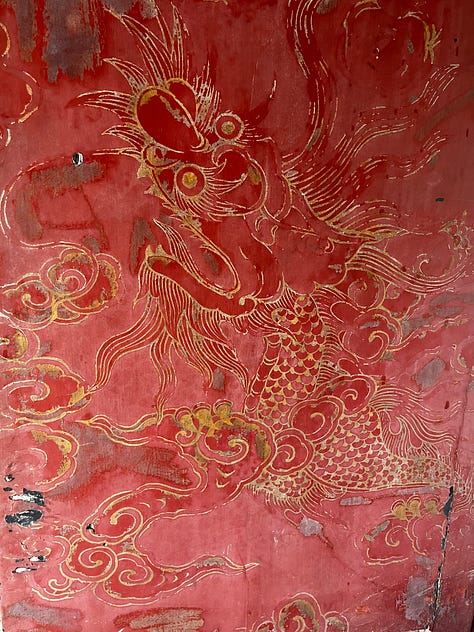


Banyan and bonsai trees are also memorable parts of this visit. One of these banyan is over 300 years old.
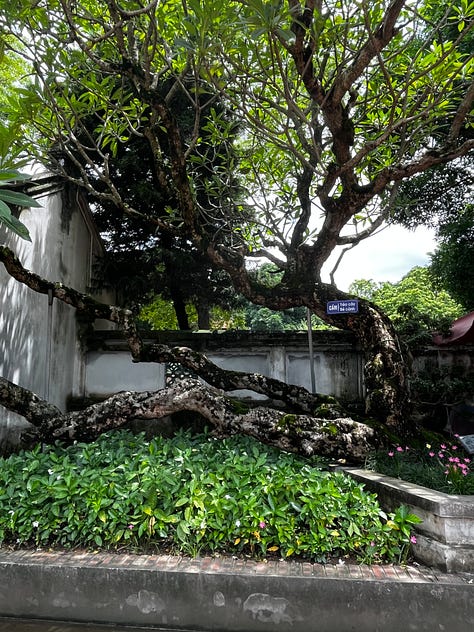

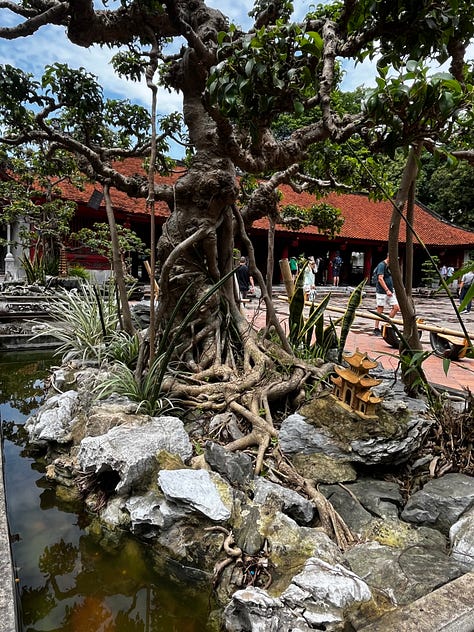






One of the most interesting parts of Văn Miếu is the set of 82 “doctoral steles,” or stone carvings created to honor those who passed the national examinations beginning in 1442. These stone turtles holding massive tablets inscribed with the value of learning and the accomplishment of each doctoral graduate have lasted almost 600 years, and most of them are in excellent condition. You can read more about them here.


These pictures show the temple for making offerings to the ancestors at the rear of the compound, two more dragons watching over the curls of burnt incense, some huge lily pads in one of the courtyard lakes, and another of the many historic bonsai.

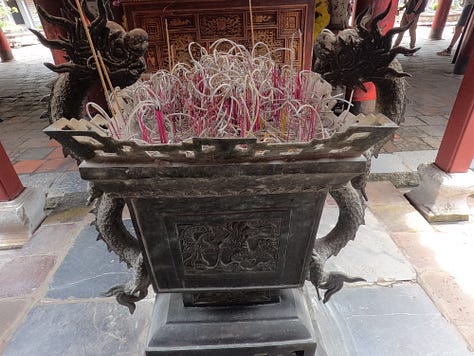




After leaving Văn Miếu, I walked about half a mile to the Vietnam National Fine Arts Museum and then spent some time in Lenin Park. I’ll make a separate post for those very interesting stops.

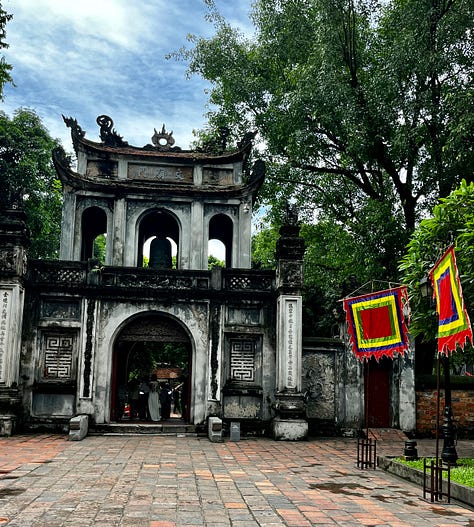




Morning Phở
Back at the hotel, I crashed hard and slept right through the informal appointment I’d made to return to one of the spas for a massage later in the evening. This morning, I’ve had ten tiny cups of coffee and finished my delicious breakfast of fresh noodles with tender sliced beef in the most fragrant broth alongside lots of fresh local fruit. I’ll probably try that massage again before seeing the Ho Chi Minh mausoleum, the One Pillar Pagoda, and Vườn bách thảo, the botanical gardens and one of the city’s oldest parks.





Thank you for sharing this incredible experience with us… I especially enjoyed waking up the stairs to the cafe and finding a table with view! ❤️
These are wonderful pictures and commentary. I'm glad you're having such a great time.